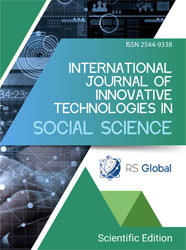SOMATIC CONSEQUENCES OF ANOREXIA NERVOSA: AN UPDATED REVIEW
Abstract
Anorexia nervosa is a group of symptoms based on conscious restriction of food intake. Anorexia disrupts the body's homeostasis, so that the functioning of many organs is impaired. These dysfunctions involve the neuroendocrine system, the cardiovascular system, the skeletal system, the digestive system, and the reproductive system. Knowing the symptoms makes it possible to make an accurate diagnosis at an early stage of the disease. This is especially important given the increasing incidence and mortality rates. This article reviews the main clinical manifestations of AN. Attention is given to both pharmacotherapies and psychotherapy.
The aim of the study: The purpose of this paper is to summarize the existing knowledge on mental anorexia nervosa. The article presents etiology, epidemiology, diagnosis, differentiation, clinical picture and treatment. The topic of eating disorders in pregnant women is also described.
Material and method: In our article we used English databases such as PubMed and Google Scholar. We selected the articles according to key words such as eating disorders, osteoporosis, cardiomyopathy, hypoglycemia, psychotherapy, medical assessment, treatment.
Conclusions: Eating disorders are a topic that unites many medical disciplines. The array of symptoms accompanying the disease clearly demonstrates the correlation of mental health with somatic health. Negative effects affect the skeletal system, neuroendocrine system, cardiovascular system, gastrointestinal system and reproductive system. Treatment is based on the use of pharmacotherapy, mainly using SSRI group drugs, as well as psychotherapy. A particularly appreciated current, among specialists, is cognitive-behavioral therapy.
References
Skowron, K., Kurnik-Łucka, M., Dadański, E., Bętkowska-Korpała, B., & Gil, K. (2020). Backstage of eating disorder—About the biological mechanisms behind the symptoms of anorexia nervosa. Nutrients, 12(9), 2604. https://doi.org/10.3390/nu12092604
Støving, R. K. (2019). Mechanisms in endocrinology: Anorexia nervosa and endocrinology: A clinical update. European Journal of Endocrinology, 180(1), R9–R27. https://doi.org/10.1530/EJE-18-0596
Grayeb, D. E., Chan, E. D., Swanson, L. M., Gibson, D. G., & Mehler, P. S. (2021). Nontuberculous mycobacterial lung infections in patients with eating disorders: Plausible mechanistic links in a case series. AME Case Reports, 5, 9. https://doi.org/10.21037/acr-20-101
Batista, M., Žigić Antić, L., Žaja, O., Jakovina, T., & Begovac, I. (2018). Predictors of eating disorder risk in anorexia nervosa adolescents. Acta Clinica Croatica, 57(3), 399–410. https://doi.org/10.20471/acc.2018.57.03.01
Skowron, K., Kurnik-Łucka, M., Dadański, E., Bętkowska-Korpała, B., & Gil, K. (2020). Backstage of eating disorder—About the biological mechanisms behind the symptoms of anorexia nervosa. Nutrients, 12(9), 2604. https://doi.org/10.3390/nu12092604
Anton-Păduraru, D. T., Trofin, F., Năstase, E. V., Miftode, R. S., Miftode, I. L., Trandafirescu, M. F., Cojocaru, E., Țarcă, E., Mindru, D. E., & Dorneanu, O. S. (2023). The role of the gut microbiota in anorexia nervosa in children and adults—Systematic review. International Journal of Molecular Sciences, 25(1), 41. https://doi.org/10.3390/ijms25010041
Grinspoon, S., Thomas, E., Pitts, S, Gross, E., Mickley, D., Miller, K., Herzog, D., & Klibanski, A. (2000). Prevalence and predictive factors for regional osteopenia in women with anorexia nervosa. Annals of Internal Medicine, 133(10), 790–794. https://doi.org/10.7326/0003-4819-133-10-200011210-00011
Neale, J., & Hudson, L. D. (2020). Anorexia nervosa in adolescents. British Journal of Hospital Medicine (London), 81(6), 1–8. https://doi.org/10.12968/hmed.2020.0099
Støving, R. K., Hangaard, J., Hansen-Nord, M., & Hagen, C. (1999). A review of endocrine changes in anorexia nervosa. Journal of Psychiatric Research, 33(2), 139–152. https://doi.org/10.1016/S0022-3956(98)00049-1
Dobrescu, S. R., Dinkler, L., Gillberg, C., Råstam, M., Gillberg, C., & Wentz, E. (2020). Anorexia nervosa: 30-year outcome. The British Journal of Psychiatry, 216(2), 97–104. https://doi.org/10.1192/bjp.2019.113
Arcelus, J., Mitchell, A. J., Wales, J., & Nielsen, S. (2011). Mortality rates in patients with anorexia nervosa and other eating disorders: A meta-analysis of 36 studies. Archives of General Psychiatry, 68(7), 724–731. https://doi.org/10.1001/archgenpsychiatry.2011.74
Atroszko, P. A., Mytlewska, W. M., & Atroszko, B. (2020). The majority of professionally active women diagnosed with eating disorders may be at risk of work addiction: An overlooked comorbidity. Health Psychology Report, 9(4), 308–337. https://doi.org/10.5114/hpr.2020.98734
Kaye, W. H., Bulik, C. M., Thornton, L., Barbarich, N., & Masters, K. (2004). Comorbidity of anxiety disorders with anorexia and bulimia nervosa. American Journal of Psychiatry, 161(12), 2215–2221. https://doi.org/10.1176/appi.ajp.161.12.2215
Hudson, J. I., Hiripi, E., Pope, H. G., Jr., & Kessler, R. C. (2007). The prevalence and correlates of eating disorders in the National Comorbidity Survey Replication. Biological Psychiatry, 61(3), 348–358. https://doi.org/10.1016/j.biopsych.2006.03.040
Witkoś, J., & Wróbel, P. (2019). Menstrual disorders in amateur dancers. BMC Women’s Health, 19, 87. https://doi.org/10.1186/s12905-019-0779-1
Teng, K. (2011). Premenopausal osteoporosis: An overlooked consequence of anorexia nervosa. Cleveland Clinic Journal of Medicine, 78(1), 50–58. https://doi.org/10.3949/ccjm.78a.10023
Fuglset, T. S. (2019). Set-shifting, central coherence and decision-making in individuals recovered from anorexia nervosa: A systematic review. Journal of Eating Disorders, 7, 22. https://doi.org/10.1186/s40337-019-0251-5
Skowrońska, A., Sójta, K., & Strzelecki, D. (2019). Refeeding syndrome as treatment complication of anorexia nervosa. Psychiatria Polska, 53(5), 1113–1123. https://doi.org/10.12740/PP/OnlineFirst/90275
da Silva, J. S. V., Seres, D. S., Sabino, K., Adams, S. C., Berdahl, G. J., Citty, S. W., Cober, M. P., Evans, D. C., Greaves, J. R., Gura, K. M., Michalski, A., Plogsted, S., Sacks, G. S., Tucker, A. M., Worthington, P., Walker, R. N., & Ayers, P.; Parenteral Nutrition Safety and Clinical Practice Committees, American Society for Parenteral and Enteral Nutrition. (2020). ASPEN consensus recommendations for refeeding syndrome. Nutrition in Clinical Practice, 35(2), 178–195. https://doi.org/10.1002/ncp.10474
Mitchell, J. S., Hermens, D. F., Bennett, M. R., Can, A. T., & Lagopoulos, J. (2023). Ketamine and zinc: Treatment of anorexia nervosa via dual NMDA receptor modulation. CNS Drugs, 37(2), 159–180. https://doi.org/10.1007/s40263-022-00984-4
Westmoreland, P., Krantz, M. J., & Mehler, P. S. (2016). Medical complications of anorexia nervosa and bulimia. The American Journal of Medicine, 129(1), 30–37. https://doi.org/10.1016/j.amjmed.2015.06.031
Hay, P. J., Touyz, S., Claudino, A. M., Lujic, S, Smith, C. A., & Madden, S. (2019). Inpatient versus outpatient care, partial hospitalisation and waiting list for people with eating disorders. Cochrane Database of Systematic Reviews, 2019(1), CD010827. https://doi.org/10.1002/14651858.CD010827.pub2
Berner, L. A., Brown, T. A., Lavender, J. M., Lopez, E., Wierenga, C. E., & Kaye, W. H. (2019). Neuroendocrinology of reward in anorexia nervosa and bulimia nervosa: Beyond leptin and ghrelin. Molecular and Cellular Endocrinology, 497, 110320. https://doi.org/10.1016/j.mce.2018.10.018
Herpertz-Dahlmann, B., & Dahmen, B. (2019). Children in need—Diagnostics, epidemiology, treatment and outcome of early onset anorexia nervosa. Nutrients, 11(8), 1932. https://doi.org/10.3390/nu11081932
Herpertz-Dahlmann, B. (2017). Treatment of eating disorders in child and adolescent psychiatry. Current Opinion in Psychiatry, 30(6), 438–445. https://doi.org/10.1097/YCO.0000000000000357
Dauty, M., Menu, P., Jolly, B., Lambert, S., Rocher, B., Le Bras, M., Jirka, A., Guillot, P., Pretagut, S., & Fouasson-Chailloux, A. (2022). Inpatient rehabilitation during intensive refeeding in severe anorexia nervosa. Nutrients, 14(14), 2951. https://doi.org/10.3390/nu14142951
Herpertz-Dahlmann, B. (2021). Intensive treatments in adolescent anorexia nervosa. Nutrients, 13(4), 1265. https://doi.org/10.3390/nu13041265
Harrington, B. C., Jimerson, M., Haxton, C., & Jimerson, D. C. (2015). Initial evaluation, diagnosis, and treatment of anorexia nervosa and bulimia nervosa. American Family Physician, 91(1), 46–52.
Lacalaprice, D., Mocini, E., Frigerio, F., Minnetti, M., Piciocchi, C., Donini, L. M., & Poggiogalle, E. (2023). Effects of mealtime assistance in the nutritional rehabilitation of eating disorders. Eating and Weight Disorders, 28(1), 73. https://doi.org/10.1007/s40519-023-01605-9
American Psychiatric Association. (2006). Treatment of patients with eating disorders, third edition. The American Journal of Psychiatry, 163(7, Suppl.), 4–54.
American College of Obstetricians and Gynecologists. (2018). ACOG Committee Opinion No. 740: Gynecologic care for adolescents and young women with eating disorders. Obstetrics & Gynecology, 131(6), e205–e213. https://doi.org/10.1097/AOG.0000000000002652
Spanos, K. E., Wright, T. S., DeAngelis, C., & Essayli, J. H. (2025). Assessing obstetrics and gynecology (OBGYN) clinicians’ knowledge, practice, and attitudes toward anorexia nervosa, atypical anorexia nervosa, and amenorrhea. Journal of Pediatric and Adolescent Gynecology, 38(3), 351–357. https://doi.org/10.1016/j.jpag.2024.12.017
Jhe, G. B., Recto, M., Vitagliano, J. A., Rose, K. L., Richmond, T., Freizinger, M., & Lin, J. (2024). Growing up in a larger body: Youth- and parent-reported triggers for illness and barriers to recovery from anorexia nervosa. Journal of Eating Disorders, 12(1), 192. https://doi.org/10.1186/s40337-024-01156-z
Boyar, R. M., Katz, J., Finkelstein, J. W., Kapen, S., Weiner, H., Weitzman, E. D., & Hellman, L. (1974). Anorexia nervosa: Immaturity of the 24-hour luteinizing hormone secretory pattern. The New England Journal of Medicine, 291(17), 861–865. https://doi.org/10.1056/NEJM197410242911701
Views:
37
Downloads:
17
Copyright (c) 2025 Martyna Grodzińska, Piotr Sobkiewicz, Karol Poplicha, Maria Ufniarska, Aleksandra Piech, Tomasz Ufniarski, Justyna Moszkowicz, Karolina Pasierb, Patrycja Kardasz, Bartłomiej Siuzdak, Marta Jutrzenka, Patrycja Ucikalak, Jarosław Ucieklak

This work is licensed under a Creative Commons Attribution 4.0 International License.
All articles are published in open-access and licensed under a Creative Commons Attribution 4.0 International License (CC BY 4.0). Hence, authors retain copyright to the content of the articles.
CC BY 4.0 License allows content to be copied, adapted, displayed, distributed, re-published or otherwise re-used for any purpose including for adaptation and commercial use provided the content is attributed.















